Gallery opened: Sept 2003
Updated: 20 Oct 2025
New quadracycle added here.
Or the quadcycle, or the quadricycle. You choose.
 
| | |
In the early history of pedal-driven vehicles, the diversity of design was truly astonishing. Bicycles, dicycles and tricycles abounded in a wide variety of configurations, with front or back wheels driven, with front or back wheels steered (or both), and with all sorts of connection between pedal and wheel. One variant that was conspicuously unsuccessful, however, was the quadracycle.
A quadracycle is basically a bicycle with four wheels, one at each corner, ridden by one or, more often, more people. One quoted advantage was stability- unlike a bicycle you could not fall off sideways, and at the time that was considered an important issue. However, a major disadvantage was its much greater weight, which was particularily onerous for a one-person model; most had two or three people pedaling. Another problem was the absence of suspension (this would have made it even heavier- almost a car without an engine) which meant that on anything other than a perfectly flat road one wheel would be off the ground, and this was at a period when most roads were unmade, and before pneumatic tyres were available to give at least some compliance. A tricycle did not have this problem.
Quadracycles have a good Wikipedia page.
Several names are in use: Quadracycle, Quadricycle, Quadcycle, or just Quad. The most commonly used is Quadracycle, so I have used it here.
 PERSONAL QUADRACYCLES
PERSONAL QUADRACYCLES
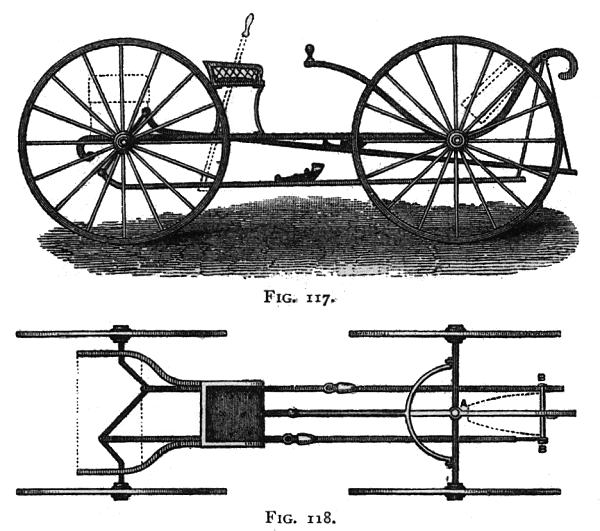 |
| Left: The Andrews quadracycle: pre-1869.
"Made of the best inch-square iron, seven feet long between the perpendiculars" which seems to indicate a rather heavy vehicle for one man to pedal.
This machine was propelled by foot-levers driving a double-cranked rear axle. The feet were pushed into shoe-like holders, which moved in an ellipse with the long axis horizontal. In the absence of differential or ackermann steering, and apparently any suspension, most of the wheels must have been slipping most of the time.
Manufactured by Mr Andrews of Dublin. My source (1869) says it was "the favourite four-wheeler of the past generation of mechanics", so it may well have been built as early as 1840.
|
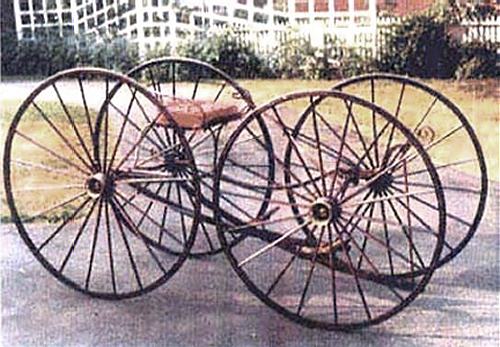 |
| Left: The Sawyer quadracycle: 1855.
The Sawyer Quadracycle is believed to have been an American production. It has wooden wheels, iron tires, and tiller front steering. Propulsion was by foot levers connected to the rear axle.
In fact, it is very much like the Andrews quad shown above, except for lighter construction. You may be wondering why the wheels are so big; this is because larger wheels roll more easily over irregularities in the road surface. In those days there were plenty of them.
This machine is at the Metz Bicycle Museum in Freehold, New Jersey.
|
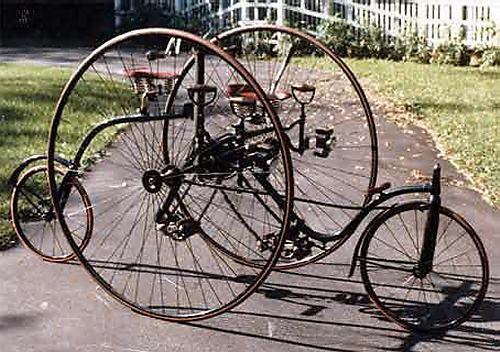 |
| Left: The Coventry Rotary quadracycle: 1885.
A quadracycle built for two.
This was a variation on the popular Coventry Rotary tricycle. The "Rotary" bit refers to the use of rotating pedals rather than foot-levers, which were common in early cycle technology.
This machine is at the Metz Bicycle Museum in Freehold, New Jersey.
|
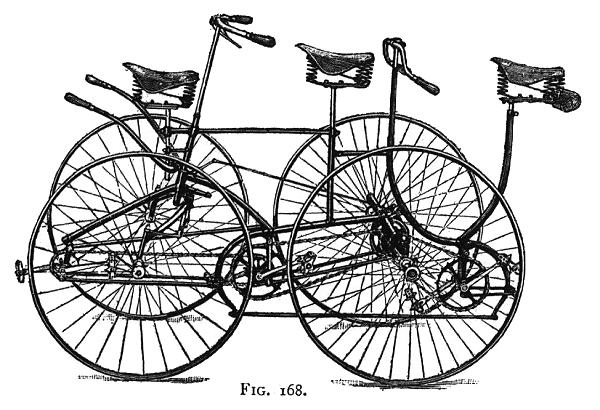 |
| Left: The Rudge quadracycle: 1888.
This was described as the first practicable quadracycle. It has seats and pedals for three, and much lighter construction. The same design was applied to a single-rider version.
The front rider steered, using the two side-levers.
The front frame carrying the two steerable wheels could swing transversely to the rear frame, enabling all four wheels to always touch the ground.
|
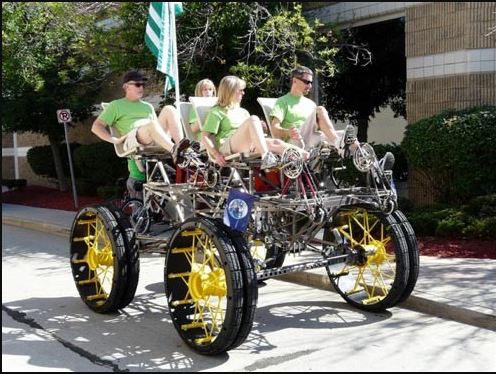 |
| Left: Modern quadracycle: 20??
This four-person quadracycle is clearly a machine for recreation only.
No details known at present.
|
 FIRE-FIGHTING QUADRACYCLES
FIRE-FIGHTING QUADRACYCLES
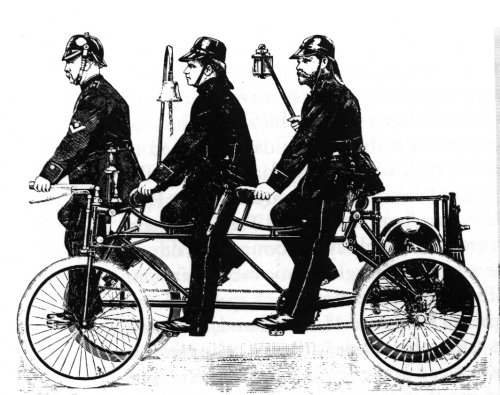 |
| Left: The fire-brigade quadracycle: 18??.
Fully equipped three-man quadracycle with bell, fire-extinguisher, and what appear to be a small hosereel and a fire-extinguisher at the back.
It is not known if this is a proposal or if it was actually ever produced.
|
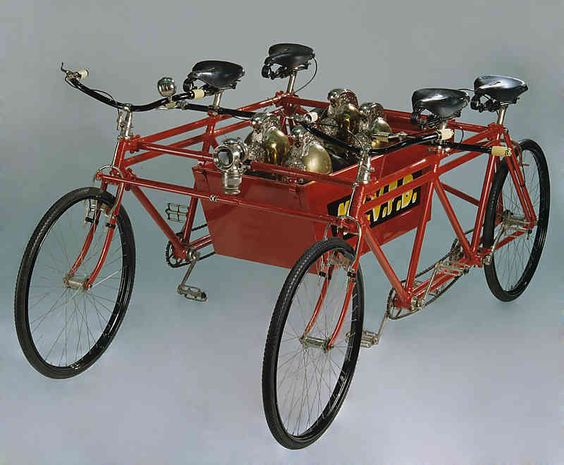 |
| Left: Fire-brigade quadracycle: 1912
This quad was built in 1912 by Howards Ltd for the New Farm Volunteer Fire Brigade, of Australia. It has a central box holding four brass helmets and an attachment for towing a hosereel trailer. The New Farm Volunteer Fire Brigade was established in 1889.
|
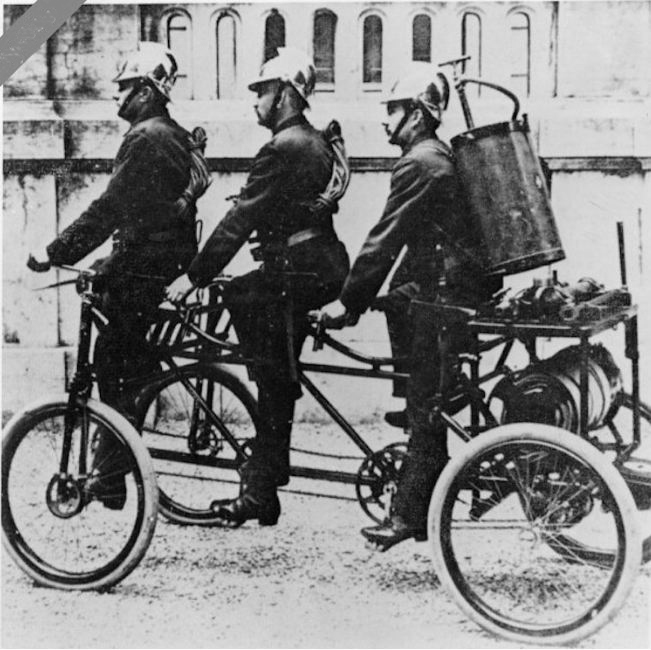 |
| Left: Swiss fire-brigade quadracycle: 1870
Another three-man fire-brigade application, with a hose reel. One has sympathy for the bloke at the back who seems to have a five-gallon tank on his back. The platform at the back seems to be holding hose nozzles.
|
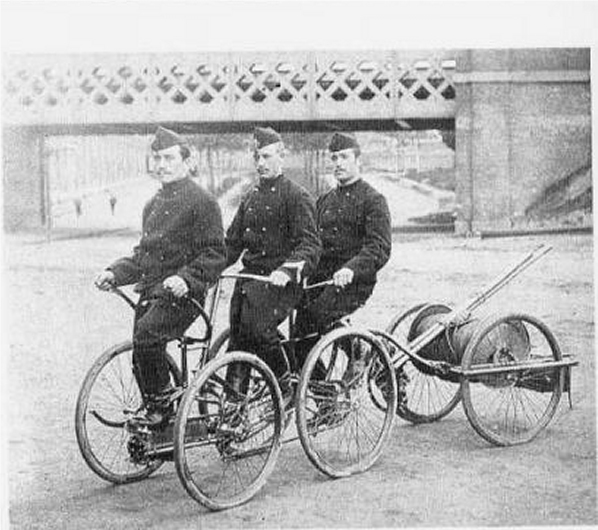 |
| Left: Fire-brigade quadracycle: 18??
Another quad, with hose reel trailer attached. It is not clear if the front or middle man is steering.
Nationality unknown but possibly Belgian, judging by the caps.
|
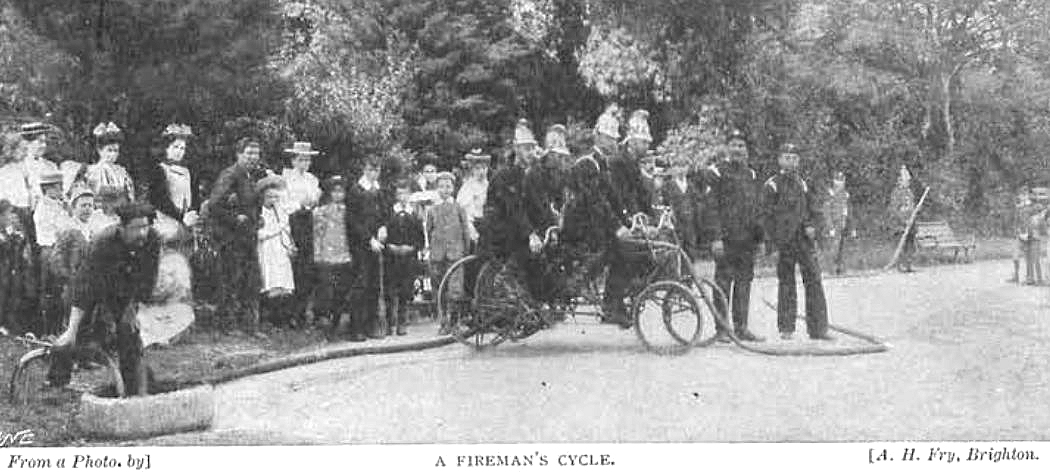 |
|
Above: Fire-brigade quadracycle: 1899
Here is an English fire-quadracycle. According to the Strand article, the four firemen are pumping water by pedal-power, the rear wheels having been lifted slightly off the ground. Water is being pumped out of a round thing, with the suction hose held by the man on the left. The delivery hose, with a nozzle held by another fireman, is on the right; no actual water seems to be emerging at present. This is clearly a demonstration as the round thing would not hold a useful amount of water.
Presumably rhere was no water tank on the quadracycle as its weight would have been prohibitive. The firemen presumably hoped that there would be a handy pond near every fire. This is very likely the reason this idea did not catch on, though a lot of countries tried it, no doubt in an attempt to save money.
Source: The Strand Magazine Vol XVII-4 1899 (exact date currently unknown)
|
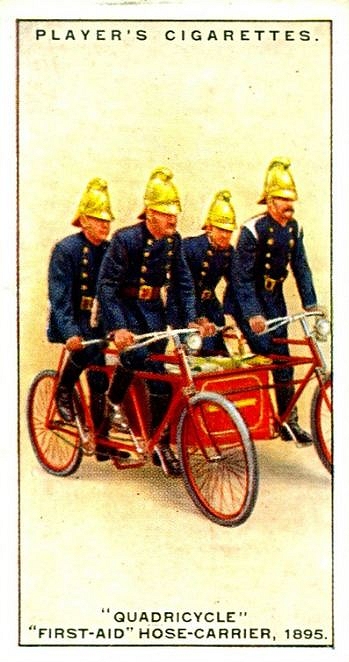 |
| Left: British fire-brigade quadracycle: 1895
Another quad with a central carrier box full of hose.
Player's cigarette card.
|
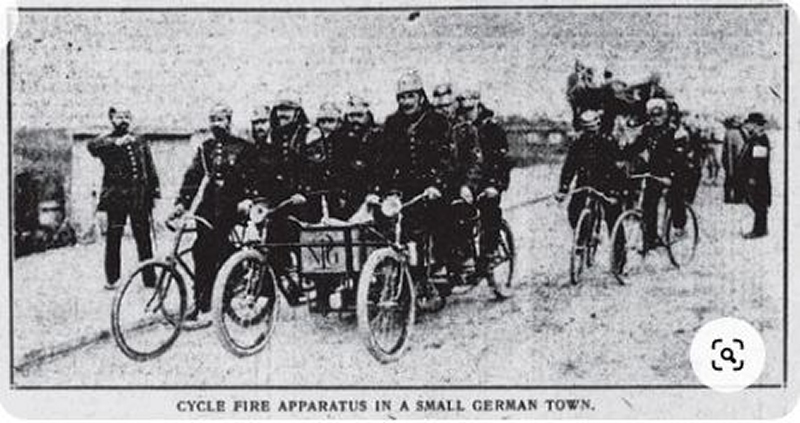 |
| Left: German fire-brigade quadracycle: 18??
It looks as if there are six men on this quad, making it the largest in this Gallery of The Museum so far. It has a central carrier box.
There are also four firemen on bicycles. The boss is presumably the man at far left, who looks as though he might be wearing a sword.
Exact location unknown.
|
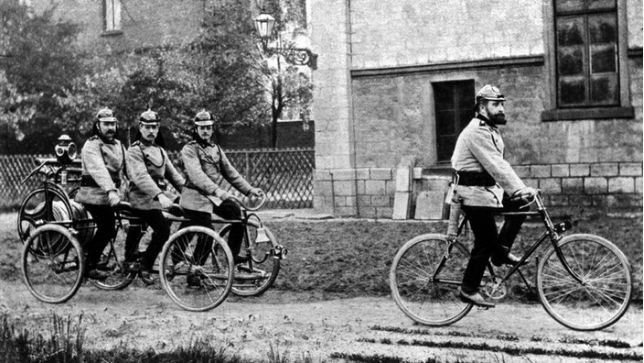 |
| Left: German fire-brigade quadracycle: 18??
Three-man quadracycle with rear hose reel.
|
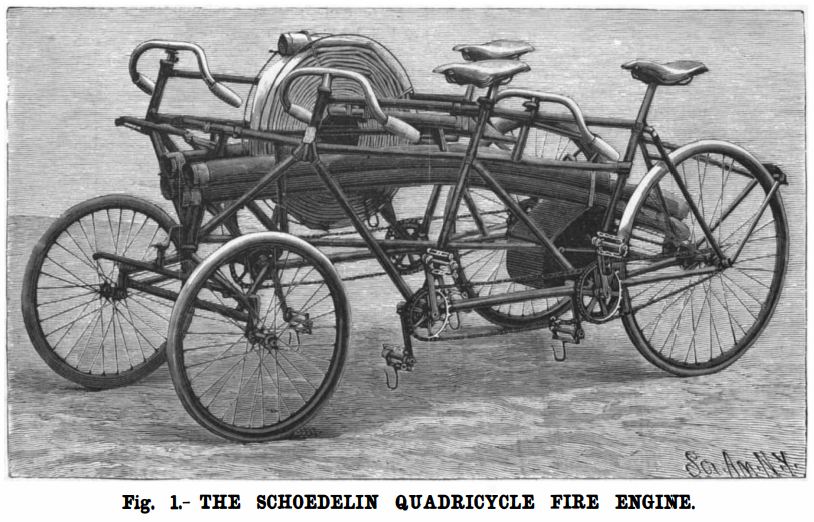 |
| Left: Schoedelin fire-brigade quadracycle: 1896
According to a Scientific American, this fire-fighting quadracyclle was exhibited 'in a recent bicycle exhibition at Paris.'
The black box at the rear is a rotary pump that can be clutched in after the rear wheels have been lifted off the ground. I quote 'The four men afterward get into their saddles and pedal in situ with a mean velocity that causes the pump to discharge about 4,500 gallons an hour in the form of a stream 100 feet in length in a horizontal direction and about 75 feet upwardly.' Sounds like hard work to me.
Source: Scientific American for 25 April 1896, p264
|
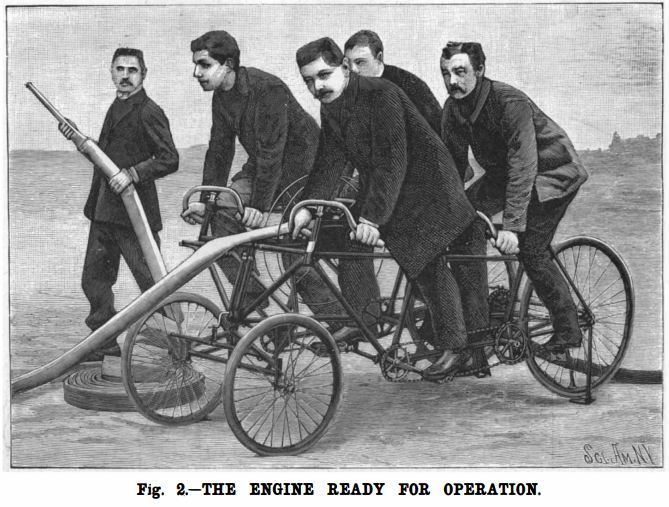 |
| Left: Schoedelin fire-brigade quadracycle: 1896
Note rear wheels lifted off the ground.
The word 'Schoedelin' does not appear in the article text. If it was a bicycle manufacturer it is unknown to Google.
Source: Scientific American for 25 April 1896, p264
|
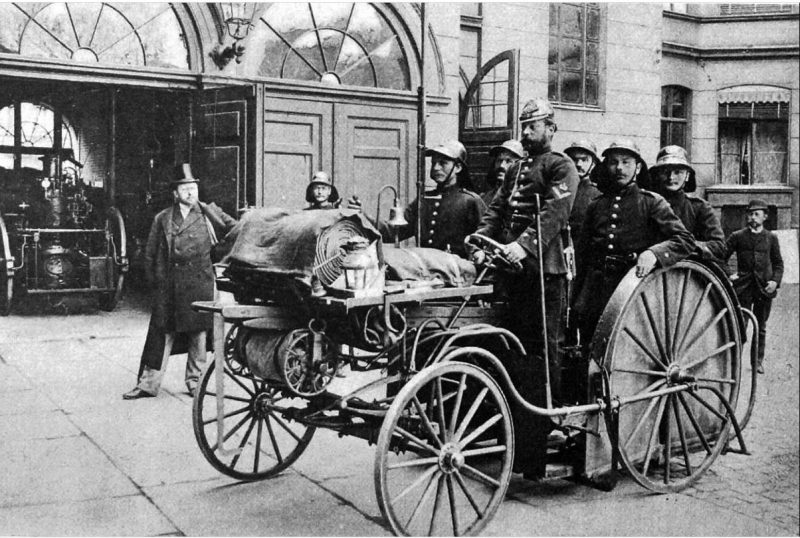 |
| Left: Berlin Fire Department quadracycle: 1894
Whether this hefty vehicle counts as a quadracycle is questionable, but it was certainly propelled by pedal-power.
It was put forward by Hermann Ganswindt, a prolific inventor. Mechanical details are currently lacking but it appears the six firemen worked some sort of treadle boards to propel the vehicle. There seems to be no provision for it to be drawn by a horse.
The man in the top hat is almost certainly Berlin Fire Director Giersberg, who authorised the experiment.
The vehicle was used for testing by the Berlin Fire Department in 1894. However there was an obvious problem; the crew were exhausted by moving the vehicle and were of limited use once they arrived at the scene of a fire.
Hermann Ganswindt lost all his money in the aftermath of World War I and died in poverty, as do most inventors, in Berlin on 25 October 1934. Ganswindt Crater on the far side of the Moon is named after him.
Source: Nordstadt Fire Department Museum.
|
 MISCELLANEOUS QUADRACYCLES
MISCELLANEOUS QUADRACYCLES
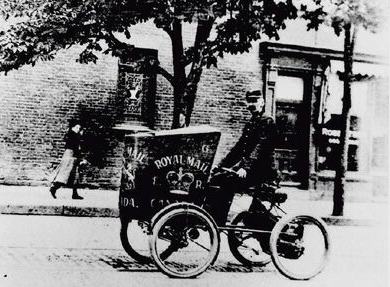 |
| Left: The Canadian Royal Mail quadracycle: 1901.
This quadracycle was use for delivering the post in Toronto in 1901. It was built by Massey-Harris.
|
The term "Quadricycle" was sometimes applied to lightweight early four-wheeled motor cars; these are not dealt with here.
Quadracycles are still very much in production; they are mostly used for recreational use in theme parks, etc, as they remain too heavy for use as serious transport. For one version, see http://www.ultimate-quadracycle.com/company.html



 PERSONAL QUADRACYCLES
PERSONAL QUADRACYCLES





 FIRE-FIGHTING QUADRACYCLES
FIRE-FIGHTING QUADRACYCLES











 MISCELLANEOUS QUADRACYCLES
MISCELLANEOUS QUADRACYCLES




